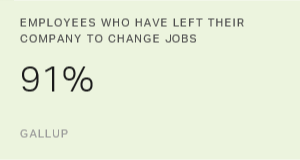Employee well-being and performance go hand in hand.
Gallup finds that workers who are thriving in all five elements of well-being (purpose, social, financial, community, physical) miss less work, have higher customer ratings, solve problems more readily and adapt to change more quickly than employees who are only thriving in one element. Employees with high well-being in all five elements also save their companies money in healthcare costs and turnover, being 81% less likely to seek out a new employer in the next year compared with adults who are only thriving in their physical well-being.
Considering the staggering links between well-being and performance, it makes sense that 80% of employers offer wellness resources and information, according to a 2015 study. The trouble is, many companies are struggling to get their workplace well-being strategies off the ground.
Because managers play a central role in employees' professional and overall lives, their dedication to employee well-being initiatives is pivotal for success. However, managers often feel uncomfortable and overwhelmed at the notion of promoting employee well-being -- unsure of best practices and resistant to being a "life coach."
When managers are uncertain about their role in well-being, companies face a major roadblock to fostering well-being. Managers set the mood and tone of work environments -- wielding the power to make or break the development of a culture of well-being.
This means that companies need to clearly establish managers' well-being responsibilities and equip them to own their role in the process. Gallup finds that progressive organizations leverage managers' influence on employee health, engagement and energy to achieve business outcomes.
To help leaders foster a culture of well-being, Gallup and Sharecare have studied well-being for years, interviewing over 3 million people worldwide since the launch of the Gallup-Sharecare Well-Being Index in January 2008. We've discovered how to dramatically improve employee well-being while preserving the integrity of manager-employee relationships -- helping organizations sustain positive outcomes for the long-term.
Gallup describes managers' roles in employee well-being using four concrete, attainable pillars. Managers amplify well-being by creating an environment that empowers employees to manage their own well-being -- not by serving as counselors or financial planners. Managers should be well-being conduits -- garnering employee ownership and connecting well-being to employees' firsthand experiences.
For companies of any type, size or industry, these four pillars offer a roadmap for creating an outcome-driving culture of well-being.
1. Invite: A culture of well-being is predicated on an open, welcoming atmosphere. Managers should not pressure well-being efforts; rather, they should advocate the importance of a life well-lived and empower employees to enhance their well-being. By setting a tone of acceptance and celebrating well-being, managers encourage employees to take personal ownership and participate as they see fit -- upholding employee autonomy and privacy, while promoting sustainable well-being growth.
2. Provide: On a regular basis, managers should connect employees with well-being opportunities and activities. Though employees are responsible for their actions, the onus is on managers to regularly invite participation and remind employees of the importance of well-being. This means pointing employees to well-being information and opportunities -- not striving to be well-being experts or advisers. By serving as a conduit to well-being, managers can enhance employee awareness dramatically.
Managers also play a part in providing a welcoming, approving, safe environment that encourages active participation in well-being practices. This requires ongoing support from leaders -- who need to consistently communicate their commitment to well-being and proactively foster a culture of well-being. Simply offering well-being information is not enough; the work culture should give employees "permission" to wholeheartedly participate. Even the most sophisticated well-being initiative is destined to fail if employees don't feel comfortable getting involved -- and it's on managers' shoulders to provide a freeing atmosphere. For example, employees should not only receive financial learning opportunities, but also feel free to briefly leave the office to attend a 401(k) consultation.
3. Model: Employees take cues from their managers -- and are more likely to take ownership of their well-being when their managers exemplify a life well-lived. For this reason, managers should model well-being to encourage employee participation and buy-in. No well-being strategy -- even the most well-developed -- can be fully adopted and optimized until managers give employees the go-ahead by illustrating the right behaviors.
Gallup finds that when a manager is thriving in well-being, their direct reports are 15% more likely to be thriving in well-being six months later. However, effective modeling does not require achieving world-class well-being. That is, managers don't need to become triathletes to demonstrate their commitment to physical well-being. Rather, managers should authentically display and share their personal well-being practices -- providing verbal and non-verbal examples of well-being in action.
4. Care: Managers need to convey that well-being initiatives are about enhancing employees' lives -- and business outcomes are only a bonus. To this end, managers should proactively communicate that they are invested in each employee and genuinely care about each individual's well-being. Encouraging employees to set well-being goals -- and asking about their progress -- is one way to show real interest in employees' well-being. In a strong culture of well-being, managers clearly demonstrate their commitment to bettering employees' holistic lives -- their purpose, social, financial, community and physical well-being.
Employees are any company's greatest asset and ought to be invested in accordingly. The world's greatest managers recognize that they affect employees' well-being every day -- for good or ill -- and make it their mission to improve lives, not just performance.
Learn more about Gallup's analytics and advice for positioning managers in a culture of well-being:
- Inquire about our comprehensive well-being solutions including surveys, audits and manager training.
- Download our How Millennials Want to Work and Live report to learn more about the emphasis this generation puts on well-being at work and in life.
- Download our Women in America: Work and Life Well-Lived report to gain a greater understanding of how well-being at work affects women's employment decisions.

